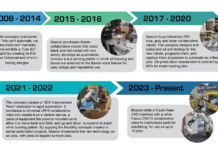Goodway Technologies
Colder weather is fast approaching, and now is the perfect time to start getting your facility or plant ready for winter. Goodway Technologies, Stamford, Connecticut, recommends performing proper maintenance and cleaning on chiller systems after shutdown to avoid headaches down the road.
Being proactive with chiller maintenance in the early winter can lead to better results in the spring when it’s time to start the systems again. Performing chiller maintenance as early as possible in the winter gives facility managers the benefit of finding major damage with plenty of time to fix the problems before the chiller needs to be back in operation.
After performing maintenance, it’s a good idea to measure efficiency gains, which can show important information, including costs saved as a result of regular maintenance. An operating log can identify areas that show improvement following chiller maintenance.
Steps to Improve Chiller Maintenance
Developing a plan for chiller maintenance can help you stay on track while keeping equipment running properly and efficiently:
- Step 1: Maintain a Daily Operating Log. The Federal Energy Management Program (FEMP) recommends updating the log four times a day to monitor key operating parameters that will help indicate if any problems are developing.
- Step 2: Keep Tubes Clean. Fouling and scale can reduce efficiency. For example, a 500-ton chiller with a moderate amount of scale deposit (0.012″) can cost an additional $7,020. Regular monitoring can identify when tube cleaning should take place, and it is recommended at least once a year. Pressure loss also can indicate tube corrosion.
- Step 3: Ensure a Leak-Free Unit. Leaks can affect the efficiency and operation of the system while releasing hazardous refrigerants. Refrigerant levels should stay within the manufacturer’s recommended levels. Using an air-purge timer (increases in air-purge time may indicate a leak), checking the refrigerant sight-glass for bubbles and checking at all joints and connections with a gas analyzer are ways to track refrigerant levels.
- Step 4: Sustain Proper Water Treatment. Between cleanings, it is important to implement a water treatment program. Water treatment helps prevent the buildup of contaminants on heat-transfer surfaces that can lead to loss of efficiency and to the growth of harmful bacteria. Each facility is different, so it is important to consult an expert to identify a proper water treatment program.
How Cooling Towers Can Boost Chiller Efficiency
If your facility has a cooling tower, it should be included in your chiller maintenance plan. Many facility managers forget that the cooling tower’s performance has a direct link to chiller efficiency. For each degree that condenser supply temperature exceeds design specifications, chiller efficiency is reduced by 2%.
Without maintenance, the warm water in cooling towers can promote algae growth, and flash evaporation can produce hard scale deposits or calcium fouling. Cooling tower fill acts like a massive air scrubber, coming into contact with dust, pollen and insects which contribute to bacteria growth. This creates a breeding ground for bacteria, such as Legionella. As with chillers, regularly cleaning cooling towers can reduce the chances of equipment corrosion or breakdowns and can increase plant efficiency.
Founded in 1966, Goodway Technologies provides innovative maintenance solutions for a wide variety of industries, including commercial HVAC, food and beverage processing, power generation and manufacturing. To learn more, visit www.goodway.com.




